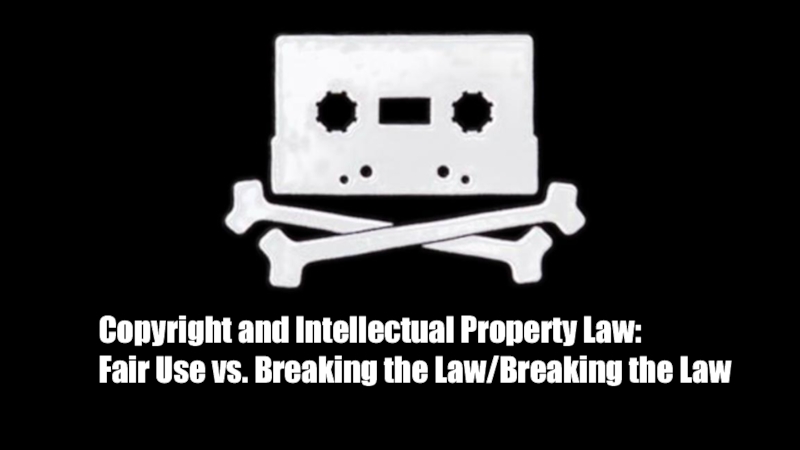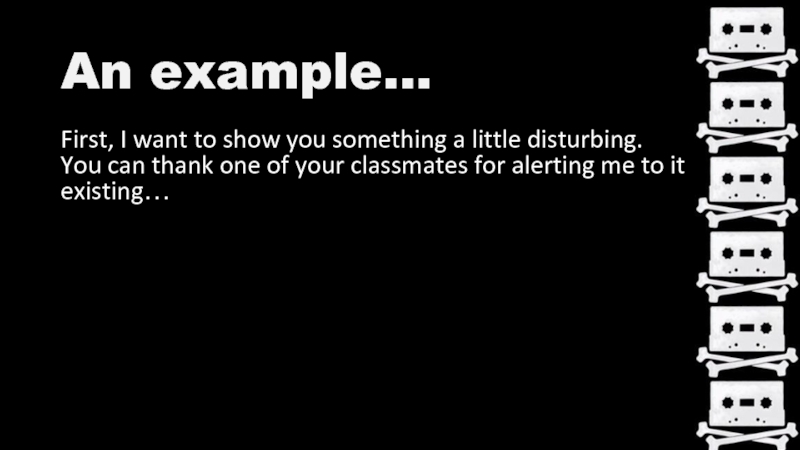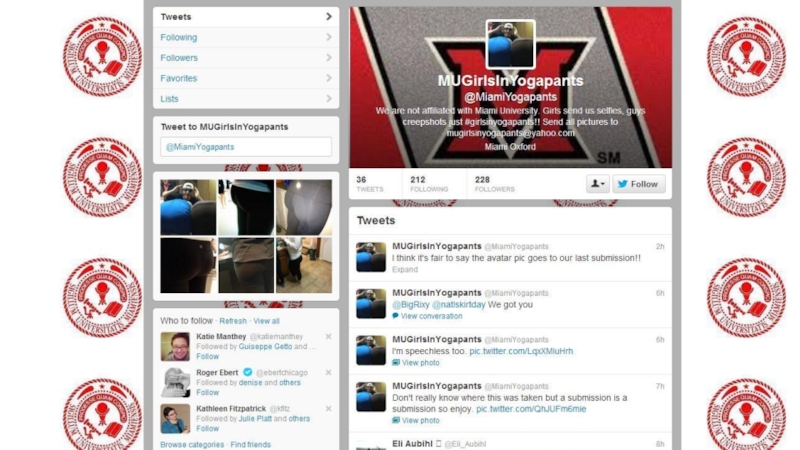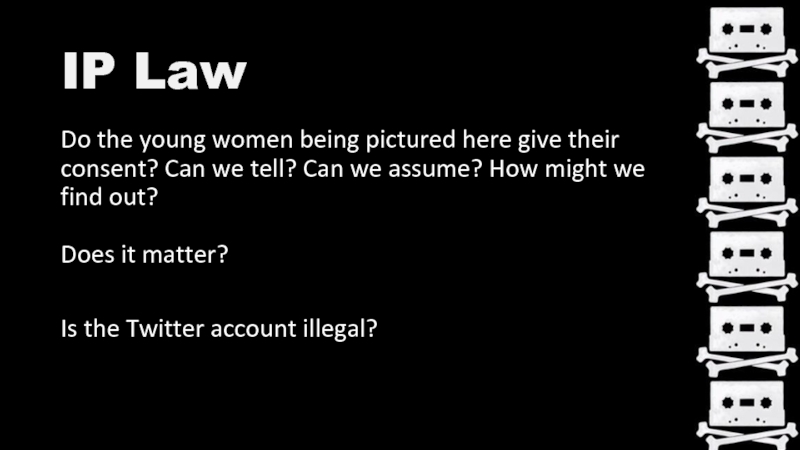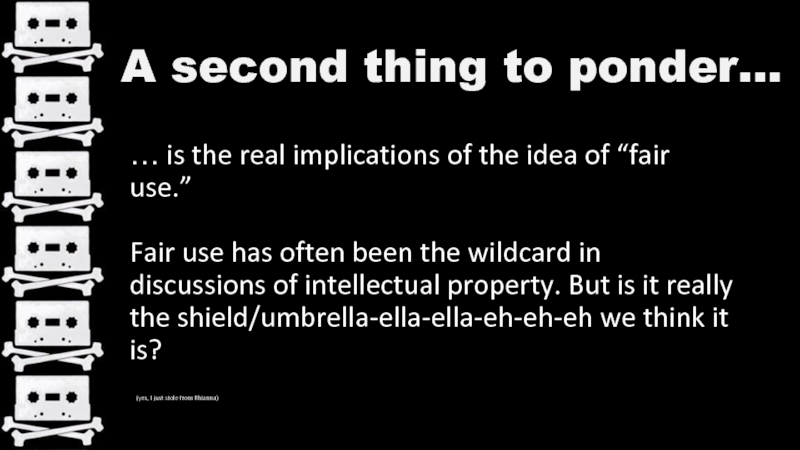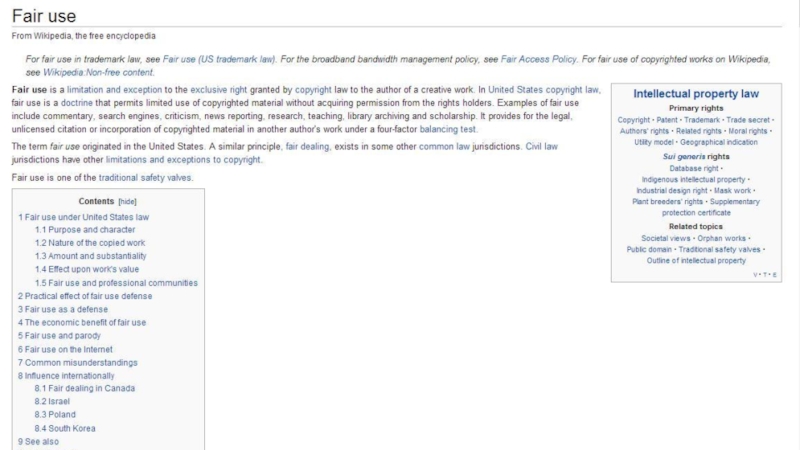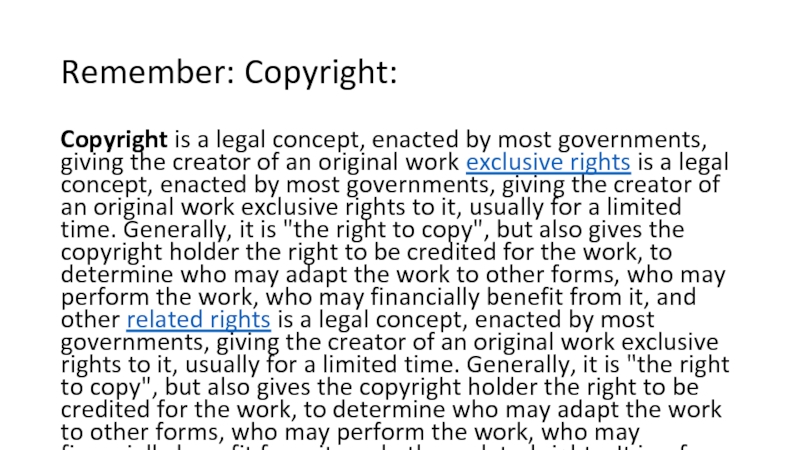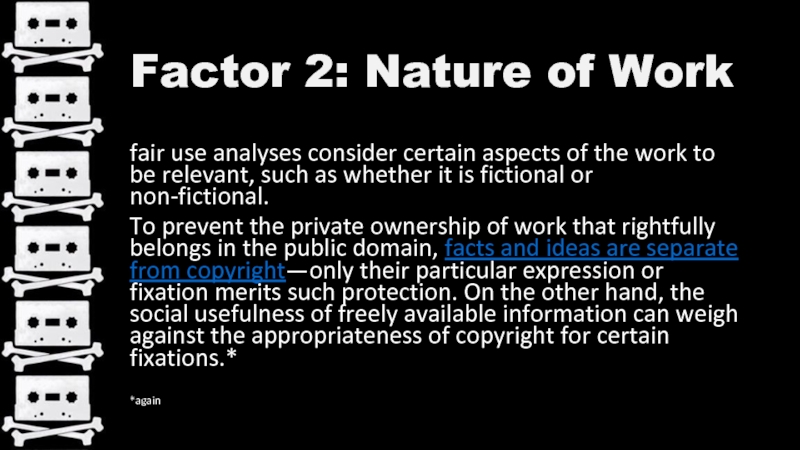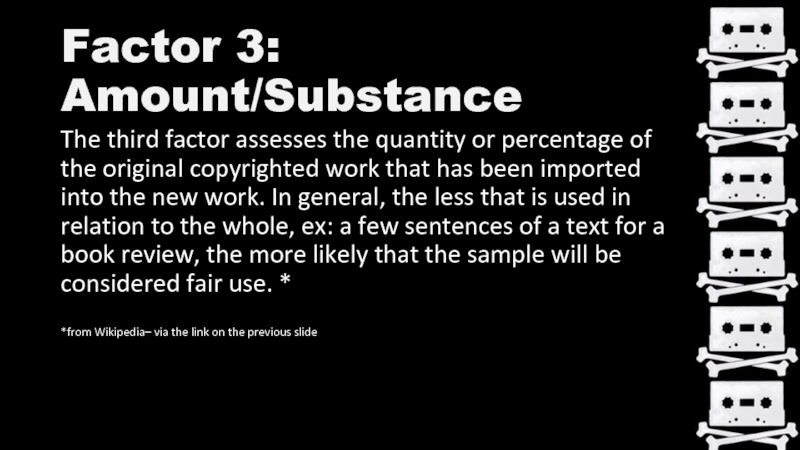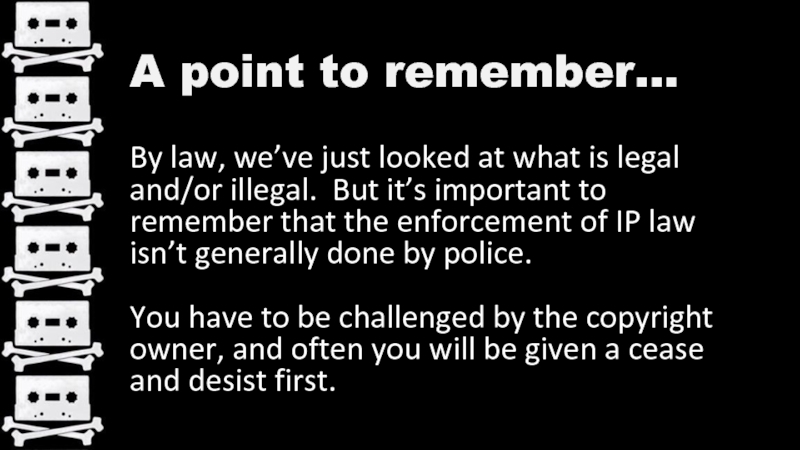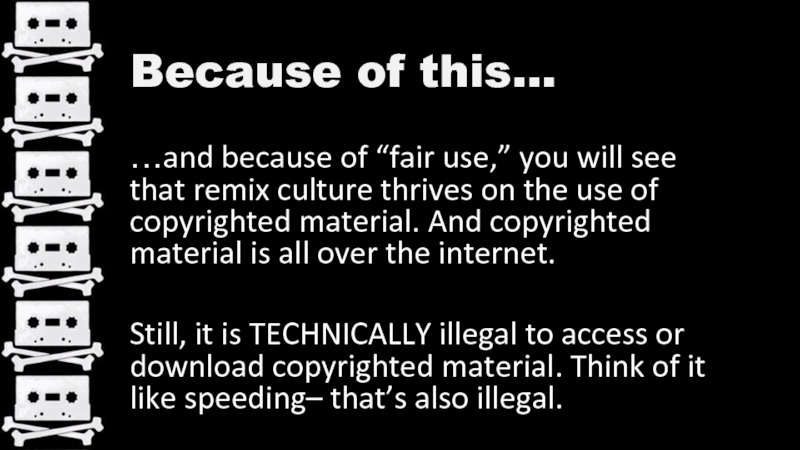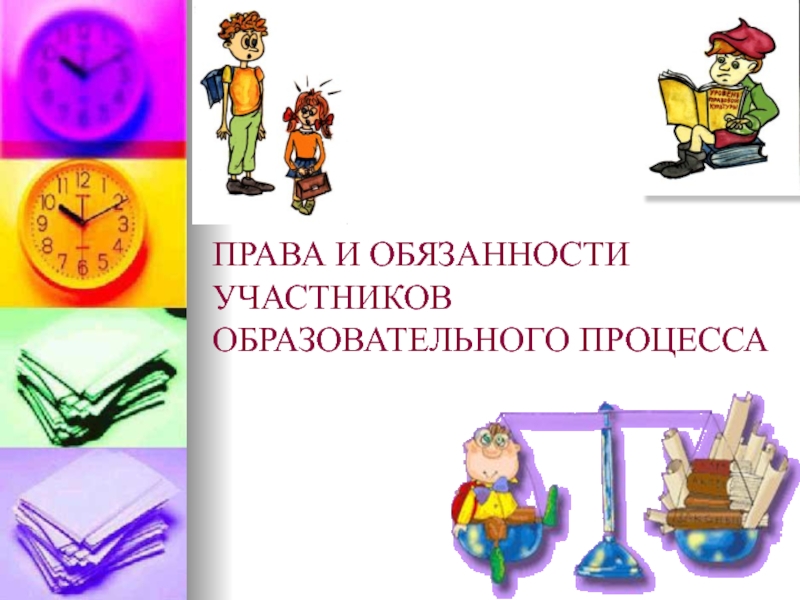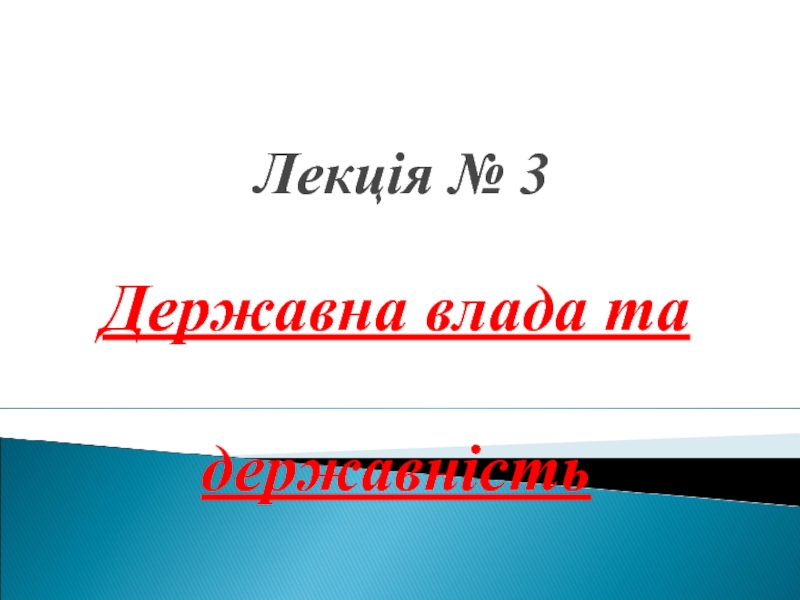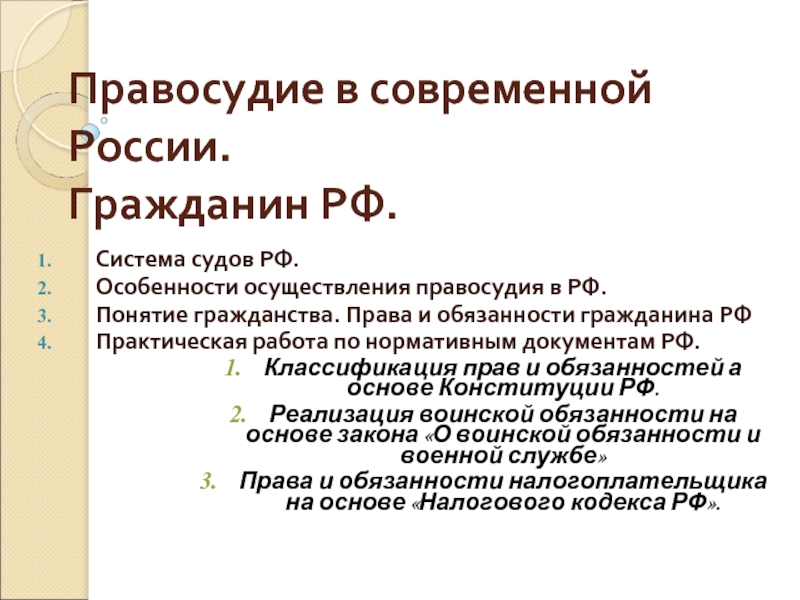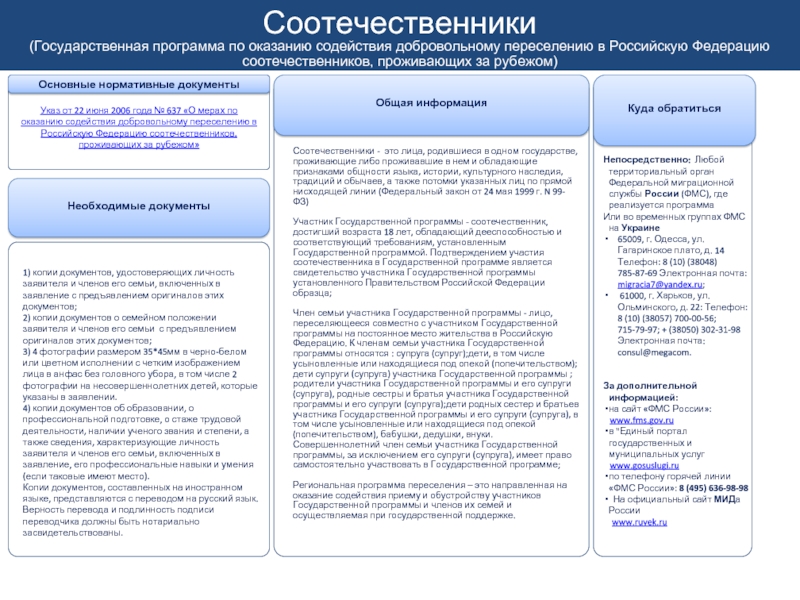Law
- Главная
- Разное
- Дизайн
- Бизнес и предпринимательство
- Аналитика
- Образование
- Развлечения
- Красота и здоровье
- Финансы
- Государство
- Путешествия
- Спорт
- Недвижимость
- Армия
- Графика
- Культурология
- Еда и кулинария
- Лингвистика
- Английский язык
- Астрономия
- Алгебра
- Биология
- География
- Детские презентации
- Информатика
- История
- Литература
- Маркетинг
- Математика
- Медицина
- Менеджмент
- Музыка
- МХК
- Немецкий язык
- ОБЖ
- Обществознание
- Окружающий мир
- Педагогика
- Русский язык
- Технология
- Физика
- Философия
- Химия
- Шаблоны, картинки для презентаций
- Экология
- Экономика
- Юриспруденция
Copyright and Intellectual Property Law:Fair Use vs. Breaking the Law/Breaking the Law презентация
Содержание
- 1. Copyright and Intellectual Property Law:Fair Use vs. Breaking the Law/Breaking the Law
- 2. An example… First, I want to show
- 4. So… What do we think of this
- 5. IP Law Do the young women being
- 6. A second thing to ponder… … is
- 8. Remember: Copyright: Copyright is a legal concept,
- 10. Factor 1: Purpose/Character The first factor is
- 11. Factor 2: Nature of Work fair use
- 12. Factor 3: Amount/Substance The third factor assesses
- 13. Factor 4: Effect on work’s value The
- 14. A point to remember… By law, we’ve
- 15. Because of this… …and because of “fair
Слайд 2An example…
First, I want to show you something a little disturbing.
You can thank one of your classmates for alerting me to it existing…
Слайд 4So…
What do we think of this Twitter account?
More importantly, from
a class perspective, is it legally okay? Is it ethical?
Please note that Dr. Phill finds this site problematic and reprehensible, but it exists and we’re studying the real digital world, not Dr. Phill’s ideal version of the digital world. Dr. Phill does not condone such activities.
Please note that Dr. Phill finds this site problematic and reprehensible, but it exists and we’re studying the real digital world, not Dr. Phill’s ideal version of the digital world. Dr. Phill does not condone such activities.
Слайд 5IP Law
Do the young women being pictured here give their consent?
Can we tell? Can we assume? How might we find out?
Does it matter?
Is the Twitter account illegal?
Is the Twitter account illegal?
Слайд 6A second thing to ponder…
… is the real implications of the
idea of “fair use.”
Fair use has often been the wildcard in discussions of intellectual property. But is it really the shield/umbrella-ella-ella-eh-eh-eh we think it is?
(yes, I just stole from Rhianna)
(yes, I just stole from Rhianna)
Слайд 8Remember: Copyright:
Copyright is a legal concept, enacted by most governments, giving
the creator of an original work exclusive rights is a legal concept, enacted by most governments, giving the creator of an original work exclusive rights to it, usually for a limited time. Generally, it is "the right to copy", but also gives the copyright holder the right to be credited for the work, to determine who may adapt the work to other forms, who may perform the work, who may financially benefit from it, and other related rights is a legal concept, enacted by most governments, giving the creator of an original work exclusive rights to it, usually for a limited time. Generally, it is "the right to copy", but also gives the copyright holder the right to be credited for the work, to determine who may adapt the work to other forms, who may perform the work, who may financially benefit from it, and other related rights. It is a form of intellectual property is a legal concept, enacted by most governments, giving the creator of an original work exclusive rights to it, usually for a limited time. Generally, it is "the right to copy", but also gives the copyright holder the right to be credited for the work, to determine who may adapt the work to other forms, who may perform the work, who may financially benefit from it, and other related rights. It is a form of intellectual property (like the patent is a legal concept, enacted by most governments, giving the creator of an original work exclusive rights to it, usually for a limited time. Generally, it is "the right to copy", but also gives the copyright holder the right to be credited for the work, to determine who may adapt the work to other forms, who may perform the work, who may financially benefit from it, and other related rights. It is a form of intellectual property (like the patent, the trademark is a legal concept, enacted by most governments, giving the creator of an original work exclusive rights to it, usually for a limited time. Generally, it is "the right to copy", but also gives the copyright holder the right to be credited for the work, to determine who may adapt the work to other forms, who may perform the work, who may financially benefit from it, and other related rights. It is a form of intellectual property (like the patent, the trademark, and the trade secret) applicable to any expressible form of an idea or information that is substantive and discrete*
*from Wikipedia
*from Wikipedia
Слайд 10Factor 1: Purpose/Character
The first factor is regarding whether the use in
question helps fulfill the intention of copyright law to stimulate creativity for the enrichment of the general public, or whether it aims to only "supersede the objects" of the original for reasons of personal profit. To justify the use as fair, one must demonstrate how it either advances knowledge or the progress of the arts through the addition of something new. A key consideration is the extent to which the use is interpreted as transformative, as opposed to merely derivative. *
*from Wikipedia– via the link on the previous slide
Слайд 11Factor 2: Nature of Work
fair use analyses consider certain aspects of
the work to be relevant, such as whether it is fictional or non-fictional.
To prevent the private ownership of work that rightfully belongs in the public domain, facts and ideas are separate from copyright—only their particular expression or fixation merits such protection. On the other hand, the social usefulness of freely available information can weigh against the appropriateness of copyright for certain fixations.*
*again
To prevent the private ownership of work that rightfully belongs in the public domain, facts and ideas are separate from copyright—only their particular expression or fixation merits such protection. On the other hand, the social usefulness of freely available information can weigh against the appropriateness of copyright for certain fixations.*
*again
Слайд 12Factor 3: Amount/Substance
The third factor assesses the quantity or percentage of
the original copyrighted work that has been imported into the new work. In general, the less that is used in relation to the whole, ex: a few sentences of a text for a book review, the more likely that the sample will be considered fair use. *
*from Wikipedia– via the link on the previous slide
Слайд 13Factor 4: Effect on work’s value
The fourth factor measures the effect
that the allegedly infringing use has had on the copyright owner's ability to exploit his or her original work. *
*again
*again
Слайд 14A point to remember…
By law, we’ve just looked at what is
legal and/or illegal. But it’s important to remember that the enforcement of IP law isn’t generally done by police.
You have to be challenged by the copyright owner, and often you will be given a cease and desist first.
Слайд 15Because of this…
…and because of “fair use,” you will see that
remix culture thrives on the use of copyrighted material. And copyrighted material is all over the internet.
Still, it is TECHNICALLY illegal to access or download copyrighted material. Think of it like speeding– that’s also illegal.
Still, it is TECHNICALLY illegal to access or download copyrighted material. Think of it like speeding– that’s also illegal.
